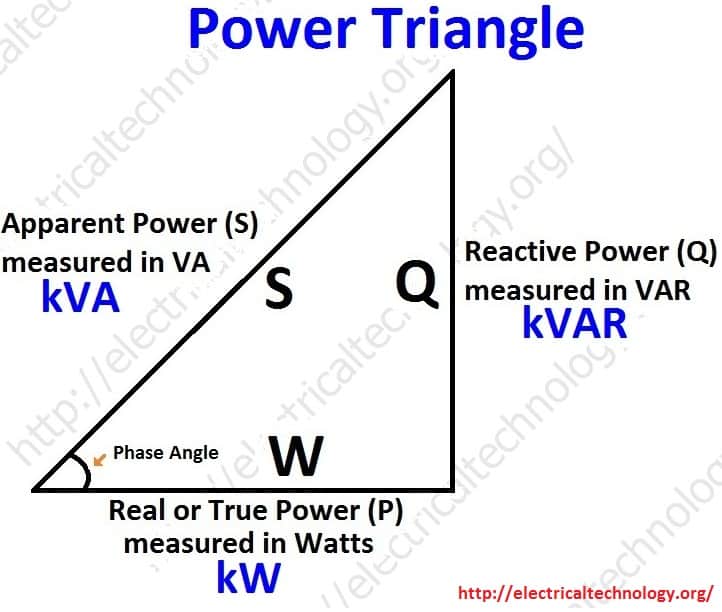Alternative words used for Real Power (Actual Power, True Power, Watt-full Power, Useful Power, Real Power, and Active Power)
In a DC Circuit, power supply to the DC load is simply the product of Voltage across the load and Current flowing through it i.e., P = V I. because in DC Circuits, there is no concept of phase angle between current and voltage. In other words, there is no Power factor in DC Circuits.
But the situation is Sinusoidal or AC Circuits is more complex because of phase difference between Current and Voltage. Therefore average value of power (Real Power) is P = VI Cosθ is in fact supplied to the load.
In AC circuits, When circuit is pure resistive, then the same formula used for power as used in DC as P = V I.
You may also read about Power Formulas in DC, AC Single Phase and and AC Three Phase Circuits.
Real Power formulas:
P = V I (In DC circuits)
P = VI Cosθ (in Single phase AC Circuits)
P = √3 VL IL Cosθ or (in Three Phase AC Circuits)
P = 3 VPh IPh Cosθ
P = √ (S2 – Q2)or
P =√ (VA2 – VAR2) or
Real or True power = √ (Apparent Power2– Reactive Power2) or
kW = √ (kVA2 – kVAR2)
(2) Reactive Power: (Q)
Also known as (Use-less Power, Watt less Power)
The powers that continuously bounce back and forth between source and load is known as reactive Power (Q)
Power merely absorbed and returned in load due to its reactive properties is referred to as reactive power
The unit of Active or Real power is Watt where 1W = 1V x 1 A.
Reactive power represent that the energy is first stored and then released in the form of magnetic field or electrostatic field in case of inductor and capacitor respectively.
Reactive power is given by Q = V I Sinθ which can be positive (+ve) for inductive, negative (-Ve) for capacitive load.
The unit of reactive power is Volt-Ampere reactive. I.e. VAR where 1 VAR = 1V x 1A.
In more simple words, in Inductor or Capacitor, how much magnetic or electric field made by 1A x 1V is called the unit of reactive power.
Reactive power formulas:
Q = V I Sinθ
Reactive Power=√ (Apparent Power2- True power2)
VAR =√ (VA2 – P2)
kVAR = √ (kVA2 – kW2)
(3) Apparent Power: (S)
The product of voltage and current if and only if the phase angle differences between current and voltage are ignored.
Total power in an AC circuit, both dissipated and absorbed/returned is referred to asapparent power
The combination of reactive power and true power is called apparent power
In an AC circuit, the product of the r.m.s voltage and the r.m.s current is calledapparent power.
It is the product of Voltage and Current without phase angle
The unit of Apparent power (S) VA i.e. 1VA = 1V x 1A.
When the circuit is pure resistive, then apparent power is equal to real or true power, but in inductive or capacitive circuit, (when Reactances exist) then apparent power is greater than real or true power.
Apparent power formulas:
S = V I
Apparent Power = √ (True power2 + Reactive Power2)
kVA = √kW2 + kVAR2
AlsoNote that;
Resistor absorbs the real power and dissipates in the form of heat and light.
Inductor absorbs the reactive power and dissipates in the form of magnetic field
Capacitor absorbs the reactive power and dissipates in the form of electric or electrostatic filed

No comments:
Post a Comment